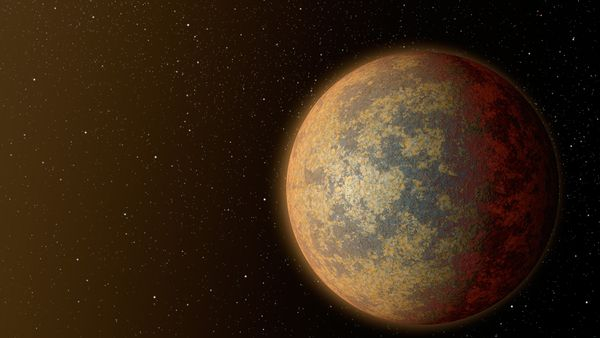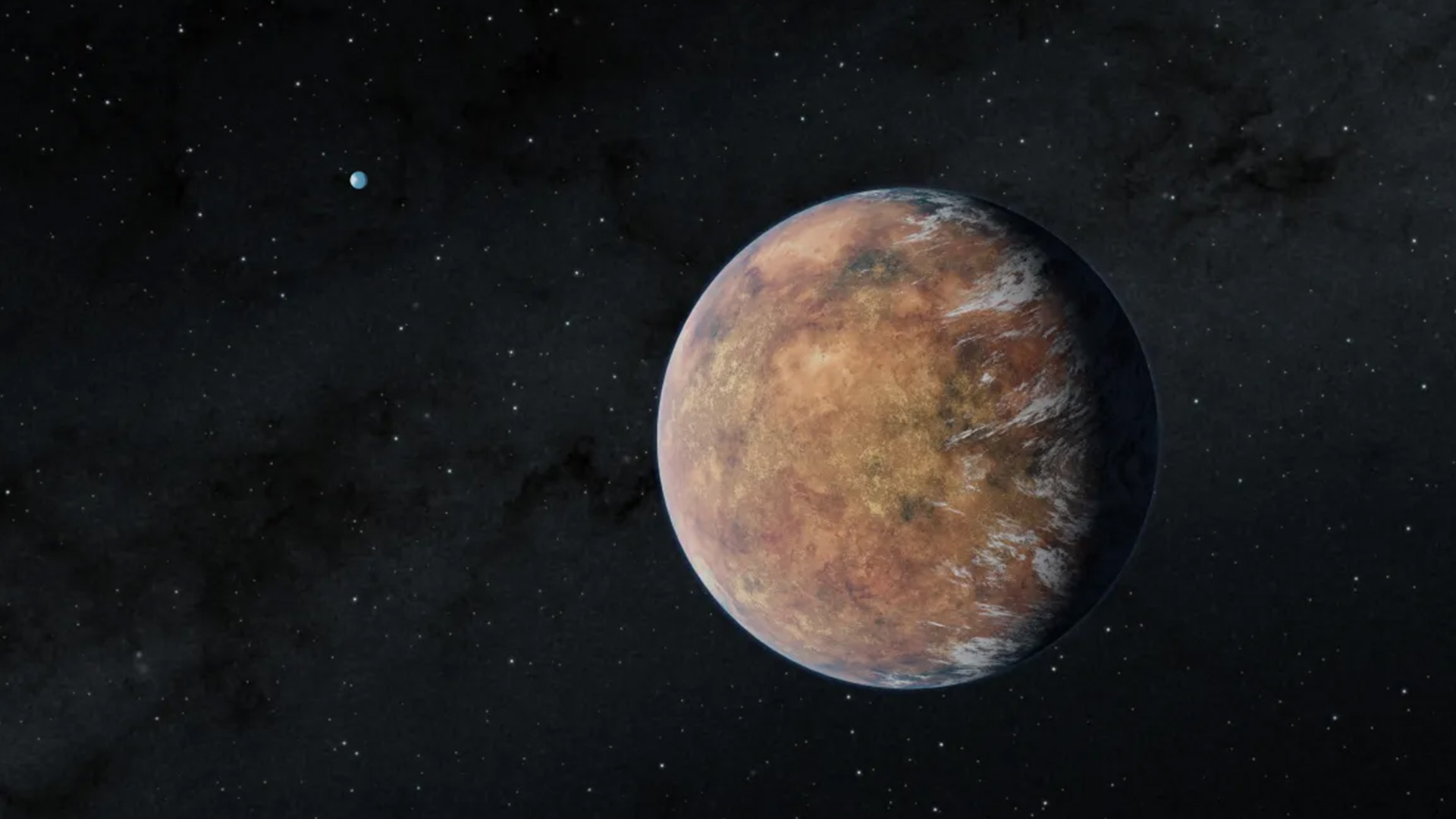The oldest continents in the Milky Way may be 5 billion years older than Earth's
Several exoplanets at the edge of our galaxy could have formed continents — and advanced life — 5 billion years earlier than Earth, new research suggests.

The oldest continents in our galaxy may have arisen 5 billion years before Earth’s, new research suggests — and that means there may be multiple worlds in the Milky Way harboring alien life even more advanced than our own.
Astrobiologists think a planet needs to have certain features to support life: oxygen in its atmosphere, something to shield organisms from dangerous radiation and liquid water, for a start. Although big land masses aren't strictly necessary for living things to emerge, Earth's history shows that they're important for life to thrive and exist for long periods of time. So, if an exoplanet had continents before Earth, it follows that there might be older, more advanced life on that world.
This line of thought led Jane Greaves, an astronomer at Cardiff University astronomer in the U.K., to answer the question: When did the first continents appear on a planet in our galaxy? Turns out, two exoplanets' continents — and perhaps life — may have arisen four to five billion years before Earth's.
If life on another planet had a five-billion-year head start, it "could potentially host life more evolved than us," Greaves wrote in a study, published in the September issue of the journal Research Notes of the American Astronomical Society.
Continents form due to plate tectonics, the movement of plates of rock that float atop the molten innards of a planet. Heat from a planet's core keeps that magma from hardening and halting continents' movement. That heat comes from radioactive elements — like uranium-238, thorium-232, and potassium-40 — in the planet's core, which give off energy as they decay.
Related: Astronomers find 2nd Earth-size planet in intriguing alien solar system
Most of those radioactive elements came from catastrophic cosmic events, like supernova explosions and collisions between the dead husks of giant stars, known as neutron stars. Traces of those elements can be detected in the wavelengths of light that stars emit. In her new work, Greaves used levels of uranium-238 and potassium present in nearby stars, plus the ages of stars as measured by the Gaia satellite, to estimate when a hypothetical rocky planet around each of these stars became hot enough for plate tectonics to emerge.
Get the Space.com Newsletter
Breaking space news, the latest updates on rocket launches, skywatching events and more!
She found that the first continents formed around nearby sun-like stars up to 2 billion years earlier than Earth's plate tectonics began. The oldest continents of a nearby star are around HD 4614, about 20 light-years from Earth. Earth's starting time, however, is average for our cosmic neighborhood.
Two stars stand out from the pack, though: The planets of two stars a bit smaller than our sun (HD 76932 and HD 201891), located 70 to 110 light-years away from us respectively in a region known as the "thick disk", could have formed continents up to 5 billion years earlier than us. Based on her sample of just 29 stars and astronomers' current best estimates for how likely a planet is to be habitable, Greaves wrote, "there could be two systems in this sample alone with biospheres more advanced than here on Earth."

Determining potentially interesting and habitable planets, like these identified by Greaves, is crucial preparation for NASA's future Habitable Worlds Observatory, which astronomers will use to observe Earth-like planets — and hopefully signs of life — in the 2040s. Greaves hopes future work will analyze more stars to determine if they could have planets with plate tectonics, which, she wrote, "could help to uncover more old systems where life on land could pre-date that on Earth."
Join our Space Forums to keep talking space on the latest missions, night sky and more! And if you have a news tip, correction or comment, let us know at: community@space.com.

Briley Lewis (she/her) is a freelance science writer and Ph.D. Candidate/NSF Fellow at the University of California, Los Angeles studying Astronomy & Astrophysics. Follow her on Twitter @briles_34 or visit her website www.briley-lewis.com.
-
rod Specific exoplanets that fit the model in the reference I did not see, When were the First Exocontinents?, https://iopscience.iop.org/article/10.3847/2515-5172/acf91a, Sep-2023. The space.com article cited some exoplanets though.Reply
This exoplanet is in the space.com article, HD 219134b. The report stated, "She found that the first continents formed around nearby sun-like stars up to 2 billion years earlier than Earth's plate tectonics began. The oldest continents of a nearby star are around HD 4614, about 20 light-years from Earth. Earth's starting time, however, is average for our cosmic neighborhood." "Two stars stand out from the pack, though: The planets of two stars a bit smaller than our sun (HD 76932 and HD 201891), located 70 to 110 light-years away from us respectively in a region known as the "thick disk", could have formed continents up to 5 billion years earlier than us. Based on her sample of just 29 stars and astronomers' current best estimates for how likely a planet is to be habitable, Greaves wrote, "there could be two systems in this sample alone with biospheres more advanced than here on Earth."
IMO, this is quite a report and model for astrobiology :) Continents on some exoplanets perhaps and perhaps more advanced *biospheres* than on Earth.
HD 219134 b is listed in a 7 exoplanet system, https://exoplanet.eu/catalog/hd_219134_b--2415/, the nasa archive site shows 6 confirmed exoplanets, https://exoplanetarchive.ipac.caltech.edu/cgi-bin/TblView/nph-tblView?app=ExoTbls&config=PS
HD 76932 is not on the confirmed exoplanet lists, https://exoplanet.eu/home/, and https://exoplanetarchive.ipac.caltech.edu/index.html, and HD 201891 does not have a confirmed exoplanet on these two sites I use.
Edit, HD 4614 this star is not found on the confirmed exoplanet lists too. -
Justman Hi there I am new here....Reply
Please explain how this was established. Who measured it 5 billion years ago or what scientific formulas was used to measure.
Who placed the instruments on these continents there to be measured.
Dont get me wrong, the one thing I fail to understand is that someone can measure something that is 5 billion or 5 million years old. Whiles recent tech that was to measure it was only recently develop. If we say we measure something then someone or some tech had to be there during the time we say it existed otherwise our fornulas is wrong. Then the formulas was created just to tell is what we want to hear.
For instance a 100 years back we invented the telephone, I now can say that the telephone is 100 years and odd old or the internet is 100 years old and the speed has evolved in such way as there was something to measure it or someone was there who wrote about it.
Now with that said who was 5 billion years on earth who measured the continents in out of space and if that is so then our tech is notnew but old has it was used 5 billion years back.
As I said I am new to this please help me understand -
billslugg The only information they have is from spectral lines. From these they can tell what a star is made of and its age. Computer models then solve for how long it took for planets to form, how hot they got and thus when plate tectonics began.Reply -
rod Keep in mind the exoplanet sites, more than 5500 confirmed now. None have been shown to have continents like Earth for example, at least nothing imaged showing this or spectroscopic analysis showing land masses and seas for example. Models in science are good but always need follow up observations from nature showing the models and assumptions used in various simulations are factual and accurate. In my post #2, what caught my attention after reading this article, some stars listed in the report, do not have confirmed exoplanets reported orbiting. As post #1 in the article states, "could have formed continents — and advanced life" None confirmed presently among the exoplanets documented now with continents and *advanced life* or any life on them.Reply -
billslugg Direct imaging of continents is going to be very difficult. At the distance of the nearest star, 4e16 m, a 1000 km continent would subtend but 1e-9 degree. Arc tan is 2.5e-11, inverted is 4e10, times wavelength of green light 600 nm, the mirror would need to be 24 km in diameter. LIGO is performing much better than that I believe. It might be possible through interferometry.Reply -
Forrester Reply
The article says by the decay of radioactive isotopes.Admin said:Several exoplanets at the edge of our galaxy could have formed continents — and advanced life — 5 billion years earlier than Earth, new research suggests.
The oldest continents in the Milky Way may be 5 billion years older than Earth's : Read more -
Questioner It is always mentioned that radioactive decay heat sustains the molten activity,Reply
but it seems rare that the tidal friction heating is included.
I would imagine tidal friction contributes some percentage of heat in Earth's case.
And that friction source must have been even greater when the moon was orbiting closer to the Earth.
Many outer moons in the Solar system are largely kept/made molten by tidal friction. -
Questioner It's borderline neurotic,Reply
but i worry about the 4cm the moon is orbiting further away each year.
Keeping our magnetic field intact keeps the life sustaining atmosphere mostly in place.
Use ALL the gravity assist from the moon as possible.
It's all 'free' energy.
Free AND beneficial. -
billslugg The Moon drains energy from the Earth. The Moon's gravity raises a tidal bulge on the side of Earth facing the Moon (bigger than the one on the side away from the Moon), the Earth's rotation sweeps some of that bulge eastward, this mass exerts a pull on the Moon with a tiny vector force in the direction the Moon is moving. This acceleration raises the Moon's orbit about 4" per year, slows the Earth's rotation down by about a second. Eventually the Moon will slow the Earth enough they will become tidally locked.Reply -
Questioner The (non-molten) moon is already tidally locked to Earth.Reply
My impression is that locking happens because there is some fixed higher density point(s) that sort of drag on rotational movement.
Like a slightly elliptical shape that spends a little extra time as its long axis points towards the source of gravity & may eventually settle there in the gravity trough between objects.
If the Earth is molten to a good degree i would think it would resist locking to some degree because higher density places would shift & change on an ongoing basis.
It wouldn't have as fixed a density location to 'snag' on the gravity trough.
Also the question of whether the shrinking gravity trough to moon because of its outward spiral will become insignificant before it has a lot more effect on Earth's rotation.
The moon was only 50,000 miles from Earth after the binary collision formed it and gave Earth its spin.
It's now 5 times as far from Earth.










